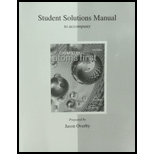
Concept explainers
(a)
Interpretation: the intermolecular forces presented in the given molecules
Concept introduction:
- Polarity of a bond is due to the difference in electro-negativities of atoms presented in it. The polarities of bonds are represented by using vectors.
- If the result of all bond polarities or vector sum is non-zero in a molecule, then the molecule is called as polar molecule.
- If the result of all bond polarities or vector sum is zero in a molecule, then the molecule is called as nonpolar molecule.
- Intermolecular force is the set of repulsive and attractive forces between molecules that result from the polarity between neighboring molecules. There are four types of intermolecular forces.
- Dipole – Dipole interaction: This force takes place between polar compounds.
- Hydrogen bonding is a type of dipole-dipole interaction of molecules when the hydrogen is bonded to strong electronegative atom (F, O, N, etc) in the molecules.
- Dispersion force is a weak force and this force is present in all compounds force.
(b)
Interpretation: the intermolecular forces presented in the given molecules
Concept introduction:
- Polarity of a bond is due to the difference in electro-negativities of atoms presented in it. The polarities of bonds are represented by using vectors.
- If the result of all bond polarities or vector sum is non-zero in a molecule, then the molecule is called as polar molecule.
- If the result of all bond polarities or vector sum is zero in a molecule, then the molecule is called as nonpolar molecule.
- Intermolecular force is the set of repulsive and attractive forces between molecules that result from the polarity between neighboring molecules. There are four types of intermolecular forces.
- Dipole – Dipole interaction: This force takes place between polar compounds.
- Hydrogen bonding is a type of dipole-dipole interaction of molecules when the hydrogen is bonded to strong electronegative atom (F, O, N, etc) in the molecules.
- Dispersion force is a weak force and this force is present in all compounds force.
(c)
Interpretation: the intermolecular forces presented in the given molecules
Concept introduction:
- Polarity of a bond is due to the difference in electro-negativities of atoms presented in it. The polarities of bonds are represented by using vectors.
- If the result of all bond polarities or vector sum is non-zero in a molecule, then the molecule is called as polar molecule.
- If the result of all bond polarities or vector sum is zero in a molecule, then the molecule is called as nonpolar molecule.
- Intermolecular force is the set of repulsive and attractive forces between molecules that result from the polarity between neighboring molecules. There are four types of intermolecular forces.
- Dipole – Dipole interaction: This force takes place between polar compounds.
- Hydrogen bonding is a type of dipole-dipole interaction of molecules when the hydrogen is bonded to strong electronegative atom (F, O, N, etc) in the molecules.
- Dispersion force is a weak force and this force is present in all compounds force.
To determine: intermolecular forces presented in
(d)
Interpretation: the intermolecular forces presented in the given molecules
Concept introduction:
- Polarity of a bond is due to the difference in electro-negativities of atoms presented in it. The polarities of bonds are represented by using vectors.
- If the result of all bond polarities or vector sum is non-zero in a molecule, then the molecule is called as polar molecule.
- If the result of all bond polarities or vector sum is zero in a molecule, then the molecule is called as nonpolar molecule.
- Intermolecular force is the set of repulsive and attractive forces between molecules that result from the polarity between neighboring molecules. There are four types of intermolecular forces.
- Dipole – Dipole interaction: This force takes place between polar compounds.
- Hydrogen bonding is a type of dipole-dipole interaction of molecules when the hydrogen is bonded to strong electronegative atom (F, O, N, etc) in the molecules.
- Dispersion force is a weak force and this force is present in all compounds force.
Want to see the full answer?
Check out a sample textbook solution
Chapter 7 Solutions
Student Solutions Manual For Chemistry: Atoms First
- Using your own words and illustrations, concisely discuss the absorption of triglycerides, phospholipids, and cholesterol esters from food. Give answer all questions with explanation.arrow_forwardSuggest a reason why decane(CH3CH2CH2CH2CH2CH2CH2CH2CH2CH3) does not exhibitliquid crystalline behavior.arrow_forwardThe structure given below has what type of glycosidic linkage?arrow_forward
- Define about Sucrose ?arrow_forwardPart C (solvents labeled C): How does the number of hydrogen bonding sites within a molecule affect the relative strength of IMF’s?arrow_forwardWhat defines a compound as optically active/inactive? What is the purpose of determining a compound’s optical activity?arrow_forward
 Chemistry for Today: General, Organic, and Bioche...ChemistryISBN:9781305960060Author:Spencer L. Seager, Michael R. Slabaugh, Maren S. HansenPublisher:Cengage Learning
Chemistry for Today: General, Organic, and Bioche...ChemistryISBN:9781305960060Author:Spencer L. Seager, Michael R. Slabaugh, Maren S. HansenPublisher:Cengage Learning
